Organization of research activities at a preschool educational institution
"Everyone small child
Crawls out of the diapers
And is lost everywhere
And is everywhere.
He is terribly upset
If anything happens,
If anything happens
In the whole world without him. "
Children are researchers by nature. An insatiable thirst for new experiences, curiosity, a constant desire to experiment, to independently seek new information about the world are traditionally considered as the most important features of children's behavior. The child asks questions relating to near and far objects and phenomena, is interested in cause-effect relationships (how? Why? Why?), Tries to independently come up with explanations for natural phenomena and people's actions. Inclined to observe, experiment. Research activities are of great interest to children. Studies provide an opportunity for a child to find answers to the questions “how? " and why? ".
Research activity is a child’s natural state, he is tuned to the knowledge of the world, he wants to know everything, to explore, to discover, to study - it means taking a step into the unknown. This is a great opportunity for children to think, try, experiment, and most importantly express themselves.
The relevance of the problem. The intellectual and personal development of children depends on the level of their cognitive activity. The problem is that in many children, a cognitive interest in the world around them is formed only under the condition of purposeful guidance from an adult. Interest will be high if the child is an active participant in the pedagogical process, if he has the opportunity to personally experiment, research, and show creativity. Today, most modern children, especially residents of large cities, rarely communicate with nature. Often, preschoolers are well aware of plants and animals from other countries, and much worse than those who live next to us.
Children's experimentation with various objects and materials opens up wide possibilities for solving this problem. The core of the experiment is the child’s research activity, which gives direction to the research search and perseverance in achieving a goal that is significant for him.
In order to organize research activities in a group, you must first start with yourself, in a different way - with the self-education of the teacher.
Stages of work on self-education
The study of methodological literature on search and research activities.
Creation of a subject - spatial developing environment in a group that promotes the manifestation of children's curiosity and cognitive activity.
Drawing up a plan and schedule for the “I want to know everything” circle.
Development of lecture notes.
Creation and design of didactic games.
Drawing up a plan of work with parents.
The implementation of the plan. Created a subject-spatial developing environment in the group, contributing to the manifestation of children's curiosity and cognitive activity. Our phytomodule has 20 indoor plants (we have plants - vacuum cleaners, plants - doctors, plants - humidifiers), an insectarium that pleases the eye with a variety of colors in the cold season, when we all lack the sun; cactus oasis grown from seeds. In an experimental mini-garden, onions, tops of root crops of carrots and parsley are planted, it turns out that they grow well and give fluffy, juicy greens. Sowing rye, sprouted on a sawdust basis, abundantly wetted with water, sprouting - hairs Chip - and Deylok. The mini-planetarium, created by the hands of dads, and the mini-laboratory "Magic Box" encourage children to new experiments, new discoveries. In the laboratory "Magic chest" master different ways actions: we examine, observe, experiment, set up, conduct experiments, learn to work independently, accumulate cognitive experience. When equipping a mini-laboratory, the following requirements were taken into account:
Safety for the life and health of children.
Adequacy.
Location availability.
Equipment: lenses, magnets, funnels, rubber pears, clay, stones, seeds, disposable glasses and spoons, trays.
In the process of experimental activity, the child develops figurative and logical thinking. He learns to compare, observe, analyze, draw conclusions, establish causal relationships. I draw attention to the fact that the child has all the senses involved, to have the opportunity to touch, smell, listen and even taste, to find answers to the question “how” and “why” myself.
No educational task can be successfully solved without fruitful contact with the family. Work with parents takes place in different forms:
Traditional Open Days
Questioning
Contests
- “Let's make a planetarium with our own hands”
- “Our tree is the best”
Poster Release
- “Earth's favorite corner” to Earth Day
- “Sorceress - water” to the Day of Water
Environmental action
Growing seedlings
Issue of posters “What should not be”
Making feeders (taking care of our smaller brothers)
Planting flowers under the motto: "My plot is more beautiful than all"
Planting greenery - planting trees on the day children graduate to school (birch, spruce, linden, bird cherry, fruiting apple tree, irigas, giving delicious berries children, adults and birds, jasmine and plum).
The knowledge gained during experiments and experiments is remembered for a long time. A Chinese proverb says: "Tell me - and I will forget, show - and I will remember, let me try - and I will understand."
When conducting experiments, I adhere to the following structure:
Formulation of the problem.
Finding solutions to the problem.
Testing hypotheses suggested by children.
Discussion of the results seen.
Formulation of conclusions.
Such an algorithm of work allows you to activate the mental activity of preschoolers, encourages them to independent research.
The theoretical basis of my work is the research of N.N. Poddyakova, who, as the main type of oriented - research (search) activity of children, distinguishes the activity of experimentation. She is leading throughout preschool age. Experimentation is a special way of spiritual and practical mastering of reality, aimed at creating conditions in which objects most clearly reveal their essence, hidden in ordinary situations.
N.N. Poddyakov emphasizes experimentation as the main type of orientational research (search) activity. The more diverse and intensive search activity, the more new information a child receives, the faster and more fully he develops.
He identifies two main types of tentative research activities.
First. Activity in the process of activity comes entirely from the child. At first, the child will, as it were, disinterestedly test various objects, then acts as its full-fledged subject, independently building its activities: it sets a goal, looks for ways and means of achievement, etc. In this case, the child satisfies his needs, his interests, his will.
Second. The activity is organized by an adult, he identifies the essential elements of the situation, teaches children a specific algorithm of action. Thus, children get the results that they previously determined.
The following are designated as the main developmental functions of cognitive research at the stage of senior preschool age:
The development of a child's cognitive initiative (curiosity)
Mastering by the child of the fundamental cultural forms of streamlining of experience: cause-effect, genus-species (classification), spatial and temporal relations;
Transfer of a child from systematization of experience at the level of practical action to the level of symbolic action (schematization, symbolization of the connections and relations between objects and phenomena of the surrounding world);
The development of perception, thinking, speech (verbal analysis, reasoning) in the process of active action to search for the connections of things and phenomena;
Broadening the horizons of children by taking them beyond the limits of direct practical experience to a wider spatial and temporal perspective (mastering the ideas about the natural and social world, elementary geographical and historical representations).
The following logic of methods is used in the experimental research model of cognitive activity:
The teacher’s questions prompting children to pose the problem (for example, remember the story of Leo Tolstoy, “I wanted to daw drink ...” What situation did the daw fall into?);
Schematic modeling of experience (creating a scheme of conducting);
Questions that help clarify the situation and understand the meaning of the experiment, its content or natural pattern;
A method that encourages children to communicate: “Ask your friend about something, what does he think about this?”;
The “first test” method of applying the results of one’s own research activity, the essence of which is the child’s determination of the personal-value meaning of the actions committed by him.
The system of work with children includes entertaining experiments and observations from the N.A. program Ryzhova “Our home is nature”, material of some sections of A.I. Ivanova on the organization of environmental observations, experiments in kindergarten.
I have developed a series of studies on the study of salt. Since older children are characterized by visual-figurative and visual-effective thinking, in my work I widely use visual material, games and game techniques. An indispensable assistant in the examination of objects is the "box of sensations."
“The best discovery is that the child makes himself.” Ralph Waldo Emerson. A child is a researcher by nature. The most important features of children's behavior are curiosity, observation, a thirst for new discoveries and impressions, the desire to experiment and search for new information about the world around the child. The task of adults is to help children maintain this research activity, as the basis for such important processes as self-education, self-education and self-development.
"People who have learned ... observations and experiences, acquire the ability to ask questions themselves and receive actual answers to them, finding themselves at a higher mental and moral level compared to those who have not passed such a school." (K.I. Timiryazev)
From work experience
Abramova Galina Yuryevna
educator of higher qualification category
MBDOU " Kindergarten compensating view "
No. 14 "Rodnichok" of the city of Aznakaevo Aznakaevsky
municipal district of the Republic of Tatarstan
In the conditions of our DOW, we use only elementary experiments and experiments.
Their elementary nature is:
firstly, in the nature of the tasks being solved: they are unknown only to children;
secondly, in the process of these experiments, scientific discoveries do not occur, but elementary concepts and conclusions are formed;
thirdly, they are practically safe;
fourthly, in such work ordinary household, gaming and non-standard equipment is used.
Directly organized activities with children (planned experiments).
Joint activities with children (observation, work, art).
Independent activity of children (work in the laboratory).
Collaboration with parents (participation in various research projects).
One of the conditions for solving problems of experimental activities in kindergarten is the organization of a developing environment.
This work began with the construction of a subject-developing environment, the selection of literature on this topic, and writing of a card index on the subject of "Children's experimentation."
In the mini-laboratory (center of science) zones can be allocated:
For a permanent exhibition where children host a museum, various collections, exhibits, rare items (shells, stones, crystals, feathers, etc.);
For appliances;
For growing plants;
For storage of materials (natural, "waste");
For conducting experiments;
For unstructured materials (sand-water table or a container for water, sand, small stones, etc.).
Instruments and equipment that can be placed in mini-laboratories:
Microscopes, magnifiers, mirrors, various scales (steelyard, floor, pharmacy, table); magnets, thermometers, binoculars, electric circuit, ropes, rulers, hourglass, globe, lamp, flashlight, whisks, whippers, soap, brushes, sponges, pipettes, gutters, disposable syringes without needles, food colors, scissors, screwdrivers, screws, grater, glue, sandpaper, rags of fabric, glue, wheels, small things from various materials (wood, plastic, metal), mills.
Capacities: plastic cans, bottles, glasses of various shapes, sizes, measurements, funnels, sieve, molds, shovels.
Materials: natural (acorns, cones, seeds, shells, knots, saw cuts, cereals, etc.); “Junk” (corks, sticks, pieces of rubber hoses, cocktail tubes, etc.).
Unstructured materials: sand, water, sawdust, wood shavings, fallen leaves, crushed polystyrene.
One of the areas of children's experimental activity that we are actively using is experiments. Experiments conducted independently with children contribute to the creation of a model of the phenomenon under study and generalization of the results obtained in an effective way. They create conditions for the opportunity to draw independent conclusions on the value significance of physical phenomena for a person from himself. Thanks to the experiments, children compare, compare, draw conclusions, express their judgments and conclusions. They experience great joy, surprise, and even delight from their small and large discoveries, which cause children a sense of satisfaction from the work done. Children like classes in which, together with adults, they make their first discoveries, learn to explain and prove. Children are happy to tell their parents about their discoveries, put the same (or more complex experiences) at home, learn to put forward new tasks and solve them independently.
We study the composition of the soil, compare the properties of sand and clay. We learn and expand our understanding of the properties of water and air, their meaning, the types and properties of fabrics, we learn about the properties of magnet and magnifying glass.
Also, in the process of experimentation, we encourage children to ask questions, highlight a sequence of actions, reflect them in a speech when answering questions like: what did we do? what did we get? why? We instill in children the skills of interpersonal communication and cooperation: be able to negotiate, defend their opinions, and reason in dialogue with other children. For this, during the discussion problem situations we draw the attention of children to the opinions of others, we teach to listen to each other, we offer more active children to help shy ones.
Experimental activity gives children the opportunity for close communication, manifestations of independence, self-organization, freedom of action and responsibility, allows for cooperation with both adults and peers. After each experiment, we teach children independence when cleaning the workplace.
Consultation for educators on the topic:
"Experimental activities in kindergarten"
Educator Bersenyova N.N.
"UNKNOWN NEARBY"
"People who have learned observations and experiences,
Acquire the ability to pose questions themselves
And get the actual answers on them, turning out
At a higher mental and moral level
Compared to those who haven’t passed such a school "
K. A. Timiryazev
What I heard, I forgot.
What I saw, I remember.
What I did, I know.
By the senior preschool age, the possibilities of initiative transformative activity of the child significantly increase. This age period is important for the development of a child’s cognitive need, which finds expression in the form of search, research activity aimed at the “discovery” of a new one that develops productive forms of thinking. In this case, the main factor is the nature of the activity. As psychologists emphasize, for the development of a child, the need for the inclusion of preschool children in meaningful activity, during which they could discover more and more new properties of objects, their similarity and difference, is crucial.
The theoretical basis for the organization of experimental and experimental activities are the research of N.N. Poddyakova, who identifies the activity of experimentation as the main type of search activity of children. In his opinion: "Children's experimentation claims to be a leading activity in the period of preschool development of the child."
Implementing the Rainbow program, studying the latest methodological literature, the results of psychological and pedagogical diagnostics, observing children, we can conclude that it is necessary to use the technology of children's experimentation in the process of their cognitive development.
Children's experimentation is one of the methods of teaching and developing natural-science representations of preschoolers. During the experimental activity, the preschooler learns to observe, reflect, compare, answer questions, draw conclusions, establish a causal relationship, and observe safety rules. The development of a systematic search and cognitive knowledge of children, the formation of experimental and experimental actions forms the basis logical thinking, provides the maximum efficiency of intellectual development of preschool children and their full readiness for learning at school.
In the organization of the experimental activities of preschoolers, it is advisable to use a complex of various forms and methods. Their choice is determined by age-related opportunities, as well as the nature of educational tasks. It must be remembered that the child should be able to express his impressions in the game, visual activity, word. Then the impressions are consolidated, gradually the children begin to feel the connection of nature with life, with themselves.
In the process of organizing pilot activities, the following tasks are expected to be solved:
inclusion of children in mental, modeling and transforming actions;
shaping the ability to see the diversity of the world in a system of relationships;
enrichment of visual aids (standards, symbols, conditional substitutes);
expanding the prospects for the development of search and cognitive activity, maintaining children's initiative, ingenuity, inquisitiveness, criticality, independence.
One of the conditions for solving problems of experimental activities in kindergarten is the organization of a developing environment. The subject environment surrounds and affects the child from the first minutes of his life. The main requirements for the environment as a developing tool is to ensure the development of active independent children's activities.
In the preparatory group for the school, a mini-laboratory can be equipped, the equipment of which was used in the classroom.
In order for the child, after conducting experiments in the mini-laboratory, together with the teacher and to continue independently to study the studied topic, the group can organize moving corners of experimentation. For example, if children studied minerals in a mini-laboratory, then in the corner of the experiment they place a collection of minerals, a set of research materials available for children's experimentation (stones, different kinds clay, sand, etc.), magnifiers, containers for experiments, reference books. The experimentation corner in this case is equipped for the period necessary to consolidate ideas about the properties of minerals and is limited to 1-2 weeks. It is a shelf on wheels with shelves on which materials and equipment are placed.
In addition to the moving corners of experimentation, the group is equipped with a stationary zone of experimental and experimental activity, in which children work independently. The materials of this zone are distributed in the following areas: “Sand and water”, “Sound”, “Magnets”, “Paper”, “Light”, “Glass and plastic”, “Rubber”.
The main equipment in the corner are:
assistant devices: magnifiers, scales, hourglass, compass, magnets;
various vessels from various materials (plastic, glass, metal, ceramics);
natural material: pebbles, clay, sand, shells, cones, feathers, moss, leaves, etc .;
recycled material: wire, pieces of leather, fur, fabric, plastic, cork, etc .;
technical materials: nuts, paper clips, bolts, studs, etc .; (slide 7)
different types paper: plain, cardboard, emery, copy, etc .;
dyes: food and non-food (gouache, watercolor, etc.);
medical materials: pipettes, flasks, wooden sticks, syringes (without needles), measuring spoons, rubber pears, etc .;
other materials: mirrors, balloons, oil, flour, salt, sugar, colored and transparent glasses, a sieve, etc.
When equipping an experiment corner, the following requirements must be considered
safety for the life and health of children;
adequacy;
location availability.
To organize independent children's activities, card-schemes of experiments can be developed. Together with children, symbols are developed that allow and prohibit signs.
The material for conducting experiments in the corner of experimentation changes in accordance with the work plan.
The technology of research provides an opportunity for the child to find answers to the questions “how?” And “why?”. But for this it is necessary not only to provide equipment for research, but also to create a problematic situation, the solution of which will lead to the discovery of any laws, phenomena, properties.
The algorithm for organizing children's experimentation was formed as follows:
the child identifies and poses a problem that must be solved;
offers various options her decisions;
checks these possible solutions based on the data;
draws conclusions.
When the technology of research activity is just introduced, the problem is determined by the teacher, for example: "How to free the beads from ice?". Then various answers are listened, and it is proposed to check them. Conclusions are corrected and recorded in observation diaries.
When this algorithm has already been developed, children can be given the freedom to choose problems and how to solve them. At this stage, special attention is paid to individual work both with difficult children and interested children.
To support interest in experimentation, some problematic situations are formulated on behalf of a fairy-tale hero. Thus, the Wise Owl can “live” in the corner of experimentation, on behalf of which tasks-notes are offered.
One day, children can find an envelope with bean and pea seeds and a note task: “Explain what appears first: a spine or a stalk?”.
Children decide that the experiment requires a transparent container and water and explain why. Then, various options are implemented: some pupils simply fill the seeds with water, someone will use cotton swabs and put the seeds between them. As a result, the children make a conclusion about the technology of seed germination (the seeds rotted in the water, disappeared in dry tampons and only in wet sprouts), and also that the root appears first, and then the stem. The duration of the experiment is 12 days.
Often, problematic situations arise from the daily lives of children.
For example: Denis, having arrived in the group in the morning, said that he has an aquarium with fish, but no feeder. Children immediately determined that the feeder should stay on the water.
In the process of searching for material for the manufacture of the feeder, an experiment was conducted on the "buoyancy" of the material. The following materials were selected: iron, wood, paper, stone, plastic film, polystyrene. The results of the experiment were recorded in the table: this material floats or does not float. Since the foam is difficult to process for children, it was decided to seek the help of parents and make a feeder at home. After a few days, the group had 12 fish feeders. All of them were donated to groups and teachers who have aquariums at home.
In the process of experimenting with children, not only intellectual impressions are formed, but also the skills to work in a team and independently develop, defend one’s own point of view, prove its correctness, determine the reasons for the failure of experimental and experimental activities, and draw elementary conclusions.
The integration of research with other types of children's activities: observations on a walk, reading, playing, allows you to create the conditions for reinforcing ideas about natural phenomena, the properties of materials, substances. For example, when introducing children to such a natural phenomenon as the wind, the causes of its occurrence, and the role in human life, the following methodical techniques can be used:
observing the movement of clouds on a walk;
experiment "What is the force of the wind?";
to consolidate the idea of \u200b\u200bthe movement of warm and cold air, the game "Different wind" (cold, warm);
reading and discussion of an excerpt from the fairy tale by A. Pushkin "The Tale of Tsar Saltan ...";
solving environmental problems, for example: “Sveta and her mother walked along the street and admired the clouds. Suddenly Sveta cried out: “Mom, on the roof of this two-story house a dandelion has grown! Who put him there? ”; “Once, scientists sailed to a small island to study animals, insects. They were very surprised that insects almost did not fly, but crawled. It turned out that they almost did not need wings. Scientists decided that the wind was to blame. Strong winds constantly blew on the island. Why dragonflies and beetles on this island almost did not fly, but crawled on the ground? ”Etc.
It is known that no educational task can be successfully solved without fruitful contact with the family and full understanding between parents and the teacher. IN individual conversationsconsultations at parent meetings through various types of visual agitation, it is necessary to convince parents of the need for daily attention to children's joys and sorrows, to encourage the child’s desire to learn new things, to find out the incomprehensible on their own, to understand the essence of objects and phenomena.
For parents, you can create a file of elementary experiments and experiments that can be done at home.
For example, “Colored ice floes” (ice can be seen not only in winter, but also at any other time of the year if you freeze water in the refrigerator).
At the parent meeting, offer games that use the results of experimentation, such as “Secret Report” (write a letter with milk on white paper and hold it over steam or iron it; write it with lemon juice, showing a few drops of iodine).
The effectiveness of the use of experimental activities as a means of cognitive development can be judged by the results of the diagnostic task-game "Yes-No" by N. B. Shumakova (the child must use the questions asked to guess what is hidden in the box without asking direct questions, such as " What is it?").
Municipal budgetary preschool educational institution "Kindergarten No. 36"
krasnokamsk
Organization of experimental research activities at a preschool educational institution
Continuing Education Program “Experimenters”
Educators:
Gafarova E. M.
Mekhonoshina N.A.
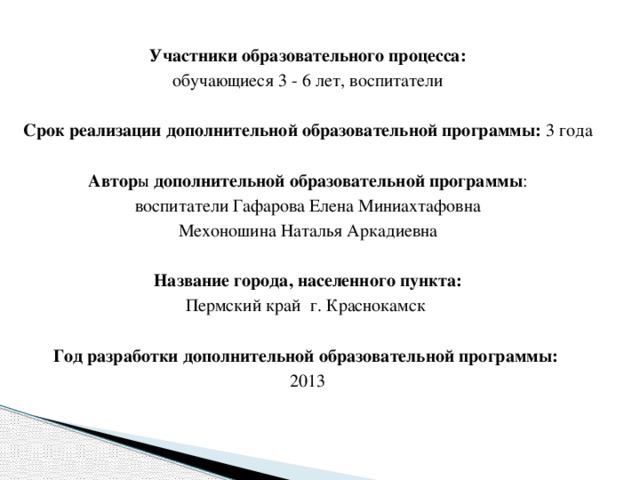
Participants in the educational process:
students 3-6 years old, educators
Duration of the additional educational program: 3 years
educators Gafarova Elena Miniahtafovna
Mekhonoshina Natalia Arkadievna
Name of city, locality:
Perm Territory Krasnokamsk
Year of development of additional educational program:
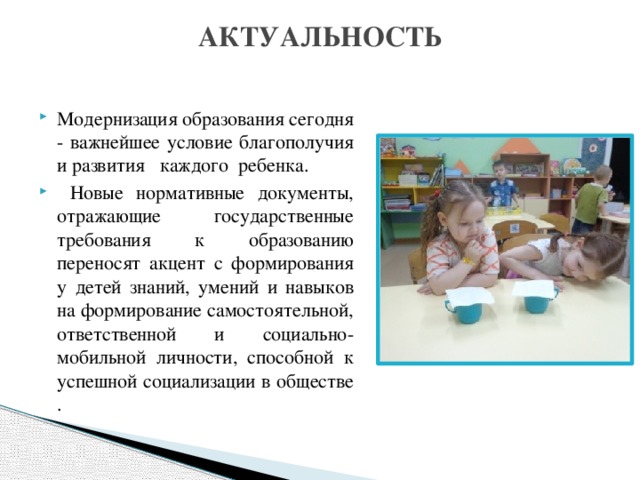
RELEVANCE
- Modernization of education today is the most important condition for the well-being and development of every child.
- New regulatory documents reflecting state requirements for education shift the focus from the formation of children's knowledge and skills to the formation of an independent, responsible and socially mobile person, capable of successful socialization in society.
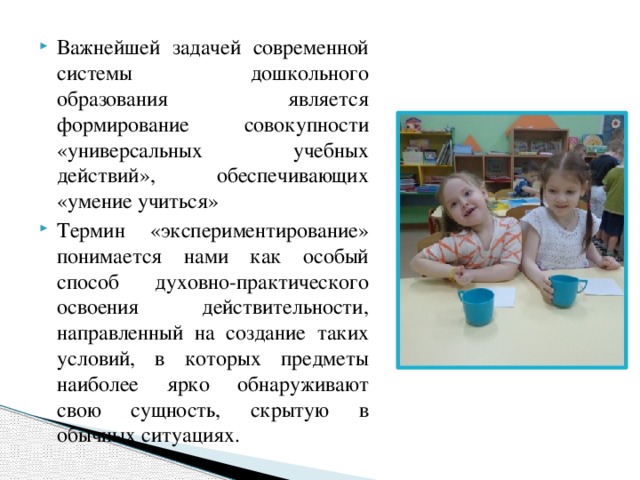
- The most important task of a modern system preschool education is the formation of a set of "universal educational actions", providing "the ability to learn"
- The term “experimentation” is understood by us as a special way of spiritual and practical mastering of reality, aimed at creating conditions in which objects most clearly reveal their essence, hidden in ordinary situations.
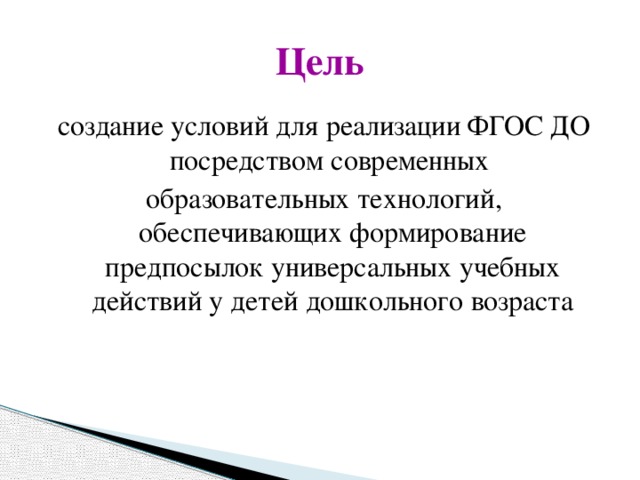
purpose
creation of conditions for the implementation of GEF DO through modern
educational technologies that ensure the formation of the prerequisites for universal educational actions in preschool children
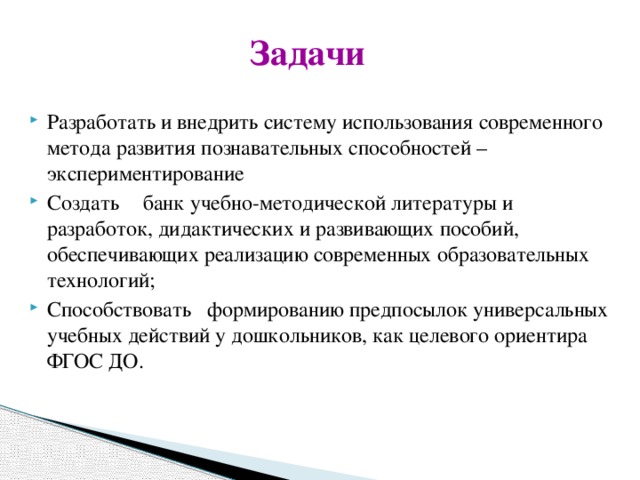
Tasks
- Design and implement a use system modern method cognitive development - experimentation
- To create a bank of educational and methodological literature and developments, didactic and developmental aids, ensuring the implementation of modern educational technologies;
- To contribute to the formation of the prerequisites for universal educational actions among preschoolers as a target of the Federal State Educational Standard.

Tasks
- to acquaint children with new ways of understanding the world through experimentation;
- to develop an emotional-value attitude to the world around .;
- to form children's mental abilities: the development of analysis, classification, comparison, generalization;
- The development of self-regulation, elementary self-control,
communication skills
independence
observation
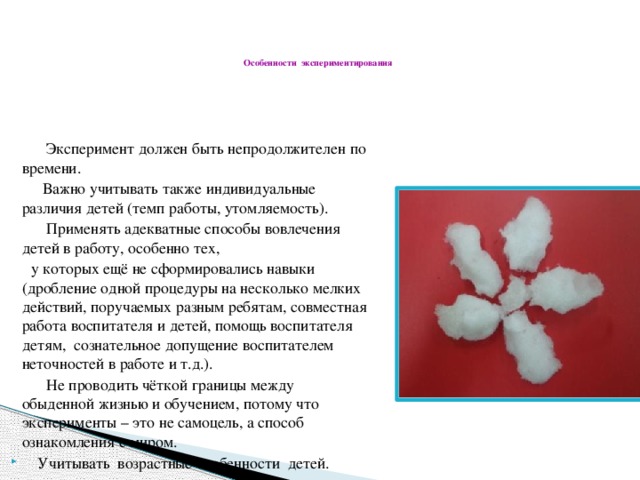
Experiment Features
The experiment should be short in time.
It is also important to consider the individual differences of children (pace of work, fatigue).
Apply adequate ways to get children involved, especially those
who have not yet developed skills (splitting one procedure into several small actions assigned to different guys, teamwork the teacher and children, the help of the teacher to children, the conscious assumption by the teacher of inaccuracies in work, etc.).
Do not draw a clear line between everyday life and learning, because experimentation is not an end in itself, but a way of getting to know the world.
- Consider age features children.
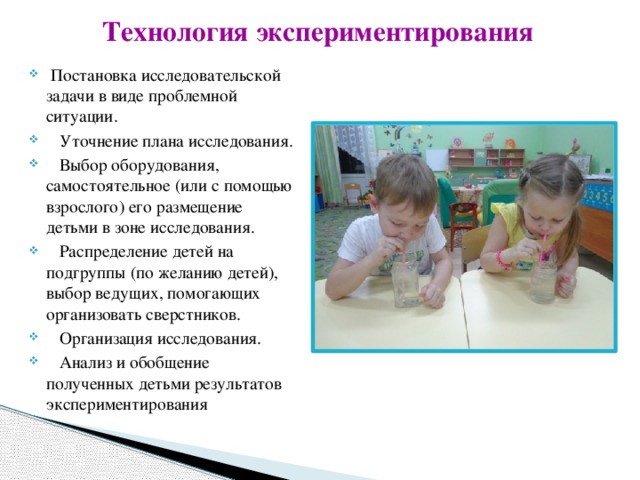
Experimentation technology
- Statement of the research problem in the form of a problem situation.
- Refinement of the research plan.
- The choice of equipment, independent (or with the help of an adult) its placement by children in the study area.
- The distribution of children into subgroups (at the request of the children), the choice of facilitators who help organize peers.
- Organization of the study.
- Analysis and generalization of experimental results obtained by children
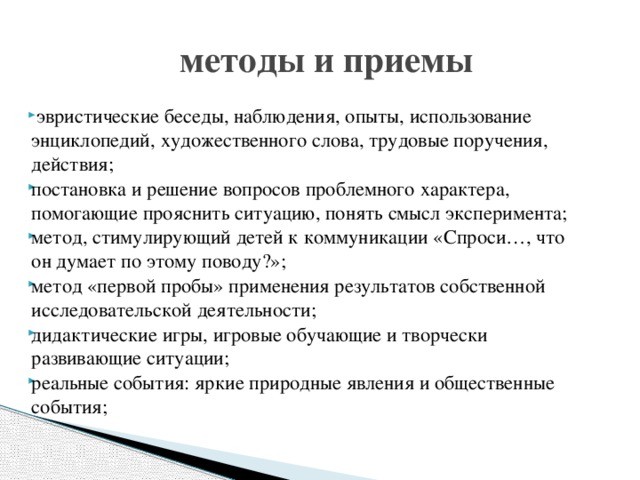
methods and techniques
- heuristic conversations, observations, experiments, the use of encyclopedias, artistic words, labor orders, actions;
- posing and resolving issues of a problematic nature that help clarify the situation, understand the meaning of the experiment;
- a method that encourages children to communicate “Ask ... what does he think about this?”;
- the “first test” method of applying the results of our own research activities;
- didactic games, educational games and creatively developing situations;
- real events: vibrant natural phenomena and social events;
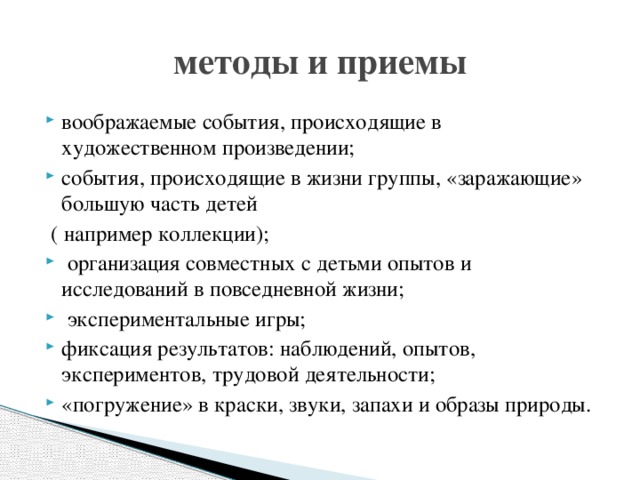
methods and techniques
- imaginary events occurring in a work of art;
- events occurring in the life of the group that “infect” most of the children
(e.g. collections);
- organization of joint experiences and research with children in everyday life;
- experimental games;
- fixing the results: observations, experiments, experiments, labor activities;
- “Immersion” in colors, sounds, smells and images of nature.
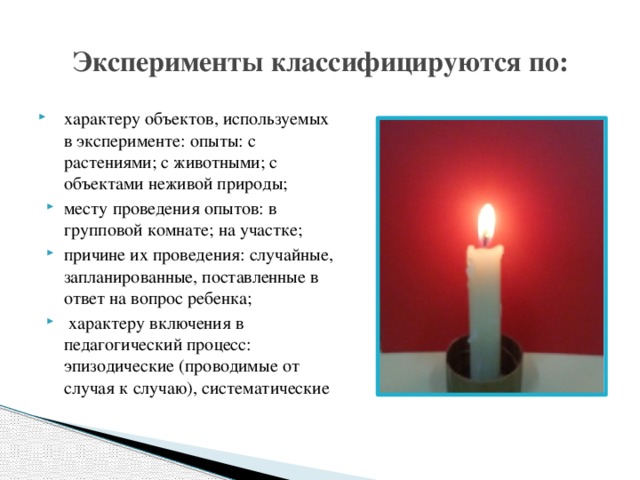
- the nature of the objects used in the experiment: experiments: with plants; with animals; with objects inanimate nature;
- place of experiments: in the group room; Location on;
- the reason for their implementation: random, planned, delivered in response to a child's question;
- the nature of inclusion in the pedagogical process: episodic (conducted from case to case), systematic
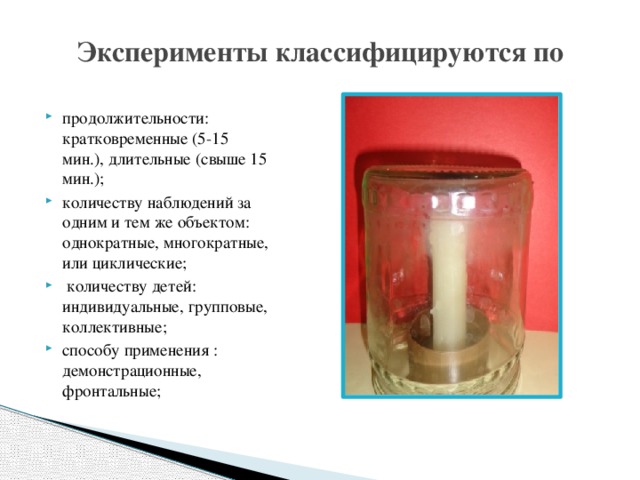
Experiments are classified by
- durations: short-term (5-15 minutes), long-term (over 15 minutes);
- the number of observations of the same object: single, multiple, or cyclic;
- number of children: individual, group, collective;
- method of application: demonstration, frontal;
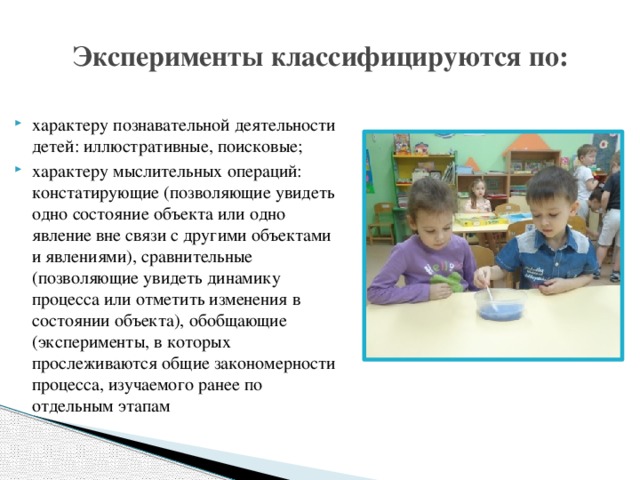
Experiments are classified by:
- the nature of children's cognitive activity: illustrative, search;
- the nature of mental operations: ascertaining (allowing you to see one state of an object or one phenomenon without being connected with other objects and phenomena), comparative (allowing you to see the dynamics of the process or note changes in the state of the object), generalizing (experiments in which the general laws of the process studied earlier are traced on separate stages
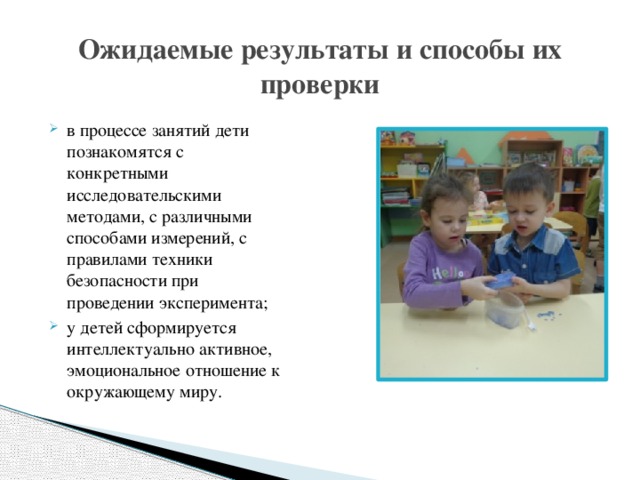
- in the process of classes, children will get acquainted with specific research methods, with various measurement methods, with safety rules during the experiment;
- children will form an intellectually active, emotional attitude to the world.
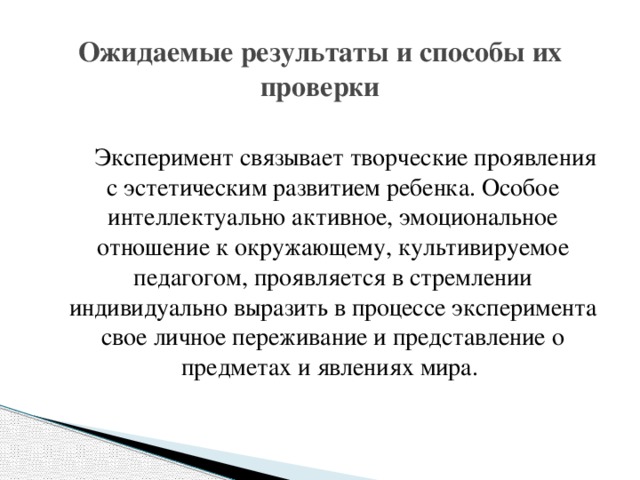
Expected Results and How to Verify Them
The experiment connects creative manifestations with the aesthetic development of the child. A special intellectually active, emotional attitude to the environment, cultivated by a teacher, manifests itself in the desire to individually express in the process of experiment his personal experience and understanding of objects and phenomena of the world.

Summary Forms
- Pedagogical advice
- Screens for parents
- DOW website
- District methodological associations
- Workshops
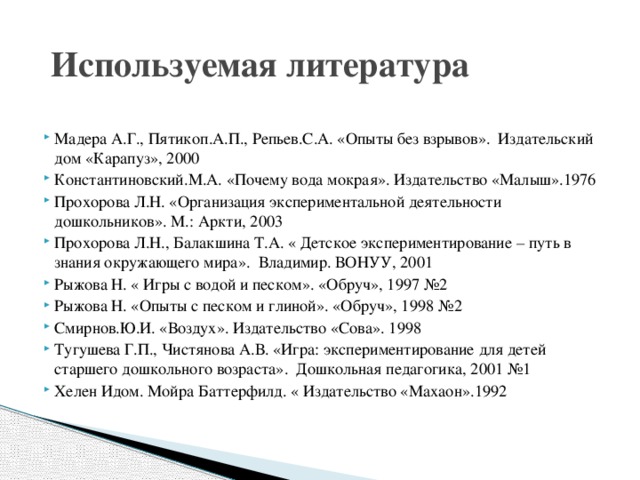
Used Books
- Madera A.G., Pyatikop.A.P., Repyev.S.A. "Experiments without explosions." Publishing house "Karapuz", 2000
- Konstantinovsky.M.A. "Why is the water wet." Publishing house "Kid" .1976
- Prokhorova L.N. "Organization of the experimental activities of preschoolers." M .: Arcti, 2003
- Prokhorova L.N., Balakshina T.A. "Children's experimentation is the path to knowledge of the world." Vladimir VONUU, 2001
- Ryzhova N. "Games with water and sand." "Hoop", 1997 №2
- Ryzhova N. "Experiments with sand and clay." "Hoop", 1998 №2
- Smirnov, Yu.I. "Air". Publishing house "Owl". 1998
- Tugusheva G.P., Chistyanova A.V. "Game: experimentation for preschool children." Preschool Pedagogy, 2001 №1
- Helen Idom. Moira Butterfield. "Publishing house" Machaon ". 1992
"Experimental activities in preschool educational institution».
"The best discovery that
which the child makes himself. "
One of the fundamental needs that underlie both cognitive and general mental development preschool children, is the need and new experiences, new knowledge. The child’s need for new impressions is the basis for the emergence and development of inexhaustible orientational research (search) activities aimed at understanding the world around us.
The more diverse and intensive the search activity, the more new information the child receives, the faster and more fully its development proceeds. Speaking of search and cognitive activity, I mean the child’s activity, directly aimed at understanding the structure of things, the connections between the phenomena of the world, their ordering and systematization. This activity originates in early childhood, at first representing a simple, as if aimless (procedural) experimentation with things, during which perception is differentiated, the simplest categorization of objects by color, shape, purpose, sensory standards, simple gun actions are mastered.
In the period of preschool childhood, “islands” of search and cognitive activity accompany the game, productive activity, interwoven into them in the form of indicative actions, testing the capabilities of any material.
Search activity is fundamentally different from any other in that the image of the goal that defines this activity is not yet ready and is characterized by uncertainty and instability. During the search, he clarifies, clarifies. This puts a special stamp on all the actions that are part of the search activity - they are extremely flexible, mobile and have a probing character. Trying actions are specific in that the child who produces them is ready for any unexpected result. This makes him very susceptible to the most diverse changes in the situation that cause his actions. All these features of search activity determine the child’s effective knowledge of many objects and phenomena available to him. Therefore, some researchers call children's experimentation as one of the types of orientational research (search) activity as the leading activity of preschool children.
So, in our kindergarten, the developing environment conducive to the cognitive development of children is represented by “centers of science” in all age groups, which made it possible to create optimal conditions for the formation of cognitive interest of children in the outside world, the development of research skills. Among the main methods of working with children in the datain the corners I relate: experimental activity, solving problem situations, during which the ability to analyze, isolate problem, search for its solution, draw conclusions and argue them. It is known that the knowledge of the world of animate and inanimate nature, the establishment of causal relationships is more successful in the process of experimental activity and experimentation.
To this end, in groups created corners equipped with everything necessary for the formation of cognitive interest of children in the outside world.
1. assistant devices (magnifying glasses, scales (steelyard), hourglass, compass, magnets, microscopes);
2. A variety of vessels made of various materials (plastic, glass, metal) of different volumes and shapes;
3. natural material (pebbles, clay, sand, shells, bird feathers, cones, saw cut and leaves of trees, moss, seeds, etc.);
4. recycled material (wire, pieces of leather, fur, fabric, plastic, wood, cork, etc.);
5. technical materials (nuts, paper clips, bolts, nails, screws, screws, designer parts, etc.);
6. different types of paper: plain, cardboard, emery, copy, etc .;
7. dyes: food and non-food (gouache, watercolor, etc.);
8. medical materials (pipettes, flasks, wooden sticks, syringes (without needles), measuring spoons, rubber pears, etc.);
9. other materials (mirrors, balloons, oil, flour, salt, sugar, colored and transparent glasses, nail file, sieve, candles, etc.).
“The role of the family in the development of search and research activity of the child.”
It is known that not a single educational or educational task can be successfully solved without fruitful contact with the family and complete understanding between parents and teachers. and parents should be aware that they are raising their children by example. Each minute of communication with the child enriches him, forms his personality.
In individual conversations, consultations, and parent-teacher meetings through various types of visual agitation, I convince parents of the need for daily attention to children's joys and sorrows, I prove how right those who build their communication with the child as an equal, recognizing the right to their own point view, who supports the cognitive interest of children, their desire to learn new things, to independently find out incomprehensible, the desire to delve into the essence of objects, phenomena, reality.
Here are some tips for parents on developing children's search and research activity.
What you can’t do and what you need to do to maintain children's interest in cognitive experimenting.
You should not dismiss the desires of the child, even if they seem impulsive to you. Indeed, at the heart of these desires may lie such an important quality as curiosity.
You can not refuse joint actions with the child, games, etc. - the child cannot develop in an atmosphere of indifference to him adults.
Short-term prohibitions without explanation hinder the activity and independence of the child.
Do not endlessly point out the mistakes and shortcomings of the child. Awareness of their failure leads to the loss of any interest in this type of activity.
The impulsive behavior of a preschooler in combination with cognitive activity, as well as his inability to anticipate the consequences of his actions, often lead to actions that we, adults, consider a violation of the rules and requirements.
Is it so?
If the act is accompanied by positive emotions of the child, initiative and ingenuity, and the goal is not to harm anyone, then this is not misconduct, but prank.
Encourage the curiosity that creates the need for new experiences, curiosity: it generates the need for research.
To provide an opportunity for a child to act with different objects and materials, to encourage experimentation with them, forming in children a motive associated with inner desires to learn new things, because it is interesting and pleasant, to help him in this with his participation.
If you have a need to prohibit something, then be sure to explain why you forbid it and help determine what is possible or how it is possible.
From early childhood, encourage the baby to complete the work he has begun to the end, emotionally evaluate his volitional efforts and activity. Your positive assessment is most important to him.
Showing interest in the child’s activities, talk with him about his intentions, goals (this will teach him goal-setting), and how to achieve the desired result (this will help to realize the process of activity). Ask about the results of the activity, about how the child achieved them (he will gain the ability to formulate conclusions, reasoning and arguing).
I will give options for joint research activities of children and parents in the use of natural situations at home.
1. In the bathroom, allow playing with empty jars, bottles, soap dishes. (Where did more water fit? Where is the water easier to draw? Why? Where is the water easier to pour? The quicker to draw water into the bath with a bucket or sponge?) This will help the child to examine and characterize objects, develop observation.
2. Experiment with objects (drown or swim in water). Do you think the bottle will drown or not? What will happen if you draw water into it? How much water do you think you need to get to drown? If you press, and then let go, what will happen?). This will help to understand what volume is, make discoveries and experiment more boldly.
3. Room cleaning (What do you think, where to start? What do you need? What will you do yourself? What will you need help with?). A similar situation develops observation, ability to plan and calculate their strength.
4. Watering flowers (Do all plants need to be watered equally? Why? Can I spray all the plants with water, and loosen the ground for all plants?). This will help educate respect to nature and to form knowledge about plants, how to care for them.
5. Repair in the room (What color wallpaper would you like to see in your room? What would you like to look at? What do you think is the best place to hang your drawings?) This will help the child learn to make judgments, fantasize, and argue his point of view.
Experimental - experimental activity allows you to combine all types of activities and all aspects of education, develops observation and inquisitiveness of the mind, develops a desire for knowledge of the world, all cognitive abilities, the ability to invent, use non-standard solutions in difficult situations, create a creative personality.
I would like my parents to follow the wise advice of V. A. Sukhomlinsky: “Be able to open one thing in front of the child in the world around us, but open it so that a piece of life plays in front of the children with all the colors of the rainbow. Always leave something unsaid so that the child wants to return again and again to what he has learned. ”
Teacher: Skurikhina S.A.
MBDOU of the city of Tulun "Kindergarten" Firefly "

Pinosol spray: instruction
Analgin tablets: instructions, reviews, analogues Terms and conditions of storage of Analgin
Ginipral - description of the drug, instructions for use, reviews
Topical solution tantum verde
Chophytol and side effects